- Submissions

Full Text
Advances in Complementary & Alternative medicine
A Comparative Study of Liver Size (Cranio-Caudal Length of Liver) by Ultrasonography in Females of Bilious (Choleric) and Phlegmatic Temperament- A Part of Haiyat-Al-Aza (Morphology)
Sameena Firdaus1*, Ferasat Ali2 and Mohd Mohsin3
1Department of Kulliyat, Allama Iqbal Unani Medical College, India
2Department of Kulliyat, Ajmal Khan Tibbiya College, India
3Department of Dermatology, Ajmal Khan Tibbiya College, India
*Corresponding author:Sameena Firdaus, Department of Kulliyat (Basic Principles of Medicine), Allama Iqbal Unani Medical College, Muzaffarnagar, Uttara Pradesh, India
Submission: August 07, 2023;Published: August 31, 2023

ISSN: 2637-7802 Volume 7 Issue 5
Abstract
Background & objective: Every person is supposed to have a unique humoral constitution that creates an equilibrium status which represents the temperament of the body. This includes his physical characteristics and physiological, psychological as well as an emotional state. The humoral compositions play an important role in the formation of the temperament. The objective of this study is to assess the maximum length (cranio-caudal) of liver in choleric (Billious) and phlegmatic temperament through ultrasonography, because liver is an important organ for formation of temperament as it is said to be the seat of the production of akhlat (humors). In Unani medicine it is believed that humours play an important and deciding role in the creation of human temperament. Thus liver being an important metabolic organ plays an important role in the formation of temperament.
Research hypothesis: Maximum (cranio-caudal) length would be relatively higher in Bilious (Safravi) than phlegmatic temperaments because as per Unani literature, the Bilious (Safravi) individuals are energetic and hyperactive than phlegmatic individuals. They have excellent metabolism; hence they have physiologically greater size of liver because liver plays an important role in metabolism. The metabolic rate of Safravi (billious) individuals are rapid than Balghami (phlegmatic), therefore the size (length) should be greater in billious than phlegmatic individuals. In comparison to billious, phlegmatic individuals have flaccid and obese body structure with soft and flabby muscles and possess more fat in their body. Fat always denotes coldness. But billious individuals are lean and thin and possess very little fat which is suggestive of the temperament being hot and dry.
Methods: This study was carried out on 100 healthy Females volunteers during the period from 2014-2017 in the age group of 18-35 years, having Choleric (Safravi) and Phlegmatic (Balghami) temperament. The reason for selecting this age group is that the volunteers in this age group are mostly healthy and disease free. The volunteer suffering from Malnutrition, Diabetes Mellitus, Hyperthyroidism, Hypothyroidism, Tuberculosis or any disease that influence liver size were excluded from the study. The temperament of the volunteers was assessed using a Performa prepared on the basis of Ajnas-e-Ashra (Ten determinants of temperament), mentioned in classical Unani literature. After the assessment and categorization of temperament, the volunteers were randomly called for ultrasound of liver for the assessments of maximum (cranio-caudal) length of liver.
Result: The mean and standard deviation of maximum length (cranio-caudal) of bilious and phlegmatic subjects were measured. It was revealed after this study that the maximum length of liver of bilious subjects was 13.422 with standard deviation 1.182 and 11.694 with standard deviation 1.402 in phlegmatic subjects. In this way it can be said that the average maximum length of liver of healthy bilious subjects is greater than that of phlegmatic subjects. The unpaired T-test was applied to test the significance of the results and it was found that the difference of maximum length of liver of bilious (Safravi) and Phlegmatic (Balghami) subjects was extremely significant (p<0.0001).
Conclusion: With the limitation of resources and time, the study sample could not be large enough, however the results show that there exists a relationship between size (length) of the liver and the temperament of an individual. The need of the hour is to understand the concept & importance of temperament (Mizaj) and its application in Unani as well as other health care.
Keywords:Temperament (Mizaj); Humor; Bilious (Safravi); Phlegmatic (Balghami); Liver
Material and Methods
The present study is an investigation in which researcher conducted the study of maximum length of liver by ultrasonography to explore the variations between the persons of bilious (safrawi) and phlegmatic (balghami) temperament.
Criterion Measures and Collection of Data
Selection of volunteers
For the present study, hundred (100-50/50) healthy volunteers of females, having phlegmatic, choleric and sanguine temperaments were randomly selected, from Indira Gandhi Hall and some other residential halls of Aligarh Muslim University and Aligarh city. This preference was given to students residing in hostels because their environment, nutritional diet from hostel mess, daily routine of college, sleeping, studying remains mostly similar and static [1-3].
Inclusion criteria
Only healthy volunteers of bilious and phlegmatic temperaments of Females in the age group of 18-35 years were included in the study.
Exclusion criteria
A. Male volunteers and volunteers below 18years and above
35 years were excluded.
B. The persons of the athletic activities, heavy exercise and
gymnastics were excluded from the study.
C. Volunteers having any history of Radiotherapy,
Chemotherapy, major accident and surgery or taking steroids
for long period were excluded from this study.
D. The volunteers, suffering from Malnutrition, Diabetes
Mellitus, Poliomyelitis, Tuberculosis, Hyperthyroidism,
Hypothyroidism or any disease that influence body shape and
size, were excluded from the study.
E. For the selection of healthy volunteers, physical, general
and local examinations were done (Annexure 3).
Ethics committee and authentication
The study has been conducted on human beings, so on the ethical ground we need approval of this study from the authorities. For the foreside an ethics committee is conducted in AKTC (Ajmal Khan Tibbiya college), AMU Aligarh. This ethics committee issued an authentication certificate for this study [4-8].
Informed consent
An informed consent form (Annexure-I) was administered by the researcher to the volunteers during study prior to their completing the other surveys or measurements.
Determination of temperament
The assessment of the temperament (Mizaj) of the volunteers was made on the basis of a self-designed performa (questionnaire) prepared in the light of criteria, described in classical Unani literature i.e. ten determinants (Ajnas-e-Ashra) and is practically use for mizaj (temperament) determination. The Performa of the temperament was given in the tabulated form to the volunteers (Annexure-II).
Categorization of individual
After determination of the temperament, selected volunteers were divided into two groups according to their temperament. Group A: Bilious temperament (Safravi Mizaj). Group B: Phlegmatic temperament (Balghami Mizaj). After determination and categorization of volunteers, they were randomly called for ultrasonography of liver. Consent was obtained from every volunteer included in the study.
Procedure
Procedure involves ultrasonography (abdomen) to measure liver span (liver size) (Figure 1-3).
Figure 1:Ultrasonography (abdomen) to measure liver span (liver size).
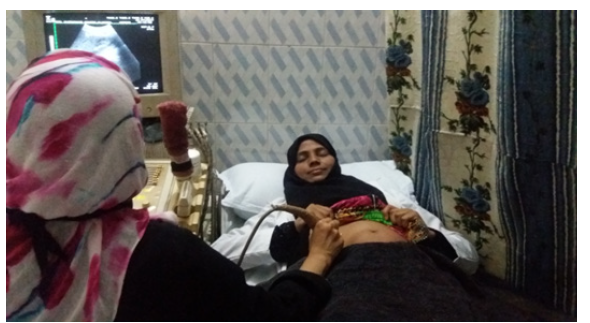
Figure 2:Bilious temperament USG.
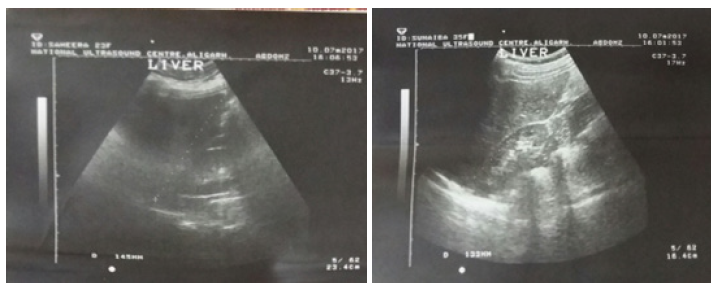
Figure 3:Phlegmatic temperament USG.

Data obtained in this study was statistically evaluated which are as follows
Maximum number of bilious temperament volunteers were found in the age group of (18-22 years - 23-27years) and maximum number of Phlegmatic temperament, volunteers were also found in the age group of (18-22 years-28-32years) Tables 1 & 2. The majority of Bilious temperament volunteers (24) were found in a group of 156-164(cm). The majority of Phlegmatic temperament volunteers (26) were found in the same age group of 156-164(cm) as shown in Table 3. By the above data it was observed that: The majority of Bilious temperament volunteers (16) were found in a group of 45-50(kg). The majority of Phlegmatic temperament volunteers (14) were found in a group of 55-60(kg) as shown in Table 4. The mean and standard deviation of bilious (Safravi) and phlegmatic (Balghami) subjects were calculated. It was revealed after this study that the mean of (cranio-caudal) length of liver of bilious (Safravi) subjects was 13.422cm with standard deviation of 1.182 while the mean of phlegmatic (Balghami) subjects was 11.694cm with standard deviation of 1.402. In this way it can be said that the average cranio-caudal length of liver of the healthy bilious subject is greater than that of a phlegmatic subject (Table 5). From the Table 6, it is evident that the mean of mid clavicular length of liver with respect to height in bilious volunteers of height group (140-148)cm were found at 12.67 with standard deviation .057 and of phlegmatic subjects lies at 11.175 with standard deviation .411. The test (unpaired t-test) found extremely significant (p value .0002).
Table 1:Showing distribution of volunteers according to the temperament.

Table 2:Showing distribution of volunteers according to age.
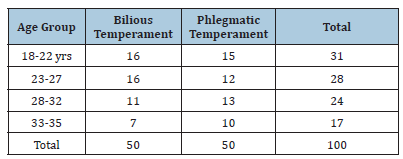
Table 3:Distribution of volunteers according to the height.
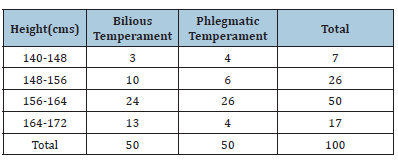
Table 4:Showing distribution of volunteers according to weight.
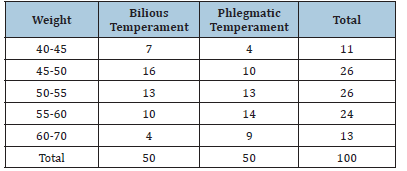
Table 5:Showing Distribution of Volunteers according to Mean Difference of cranio-caudal length of liver of volunteers.

Table 6:Showing comparison of cranio-caudal (mid-clavicular) length of liver with heights of volunteers.

As after statistical analysis and from the depiction of Table 7 it was revealed that the mean difference of cranio-caudal length of bilious volunteers among the group weighing from 40-45kg was found to be 12.745 with standard deviation .0828 , the mean of cranio-caudal length of phlegmatic volunteers in the same weight group obtained at 11.075 with standard deviation 0.465, so the test (unpaired t-test) for this group volunteers was found to be very significant after comparative study of the mean of the cranio-caudal length of liver in both the temperaments. The mean of liver length of bilious volunteers in the weight group 45-50kg came to lie at 13.262 with standard deviation 1.263 and the mean of phlegmatic was found to be at 10.75 with standard deviation 0.462, the test was found extremely significant for this group volunteers. The bilious volunteers in the weight group from 50-55kg were found at 13.807 for mean with standard deviation 1.279 approximately, the phlegmatic volunteers for this weight group came to lie at 12.238 with standard deviation 1.537 and the test found to be very significant for this weight group. The next weight group (55-60) kg for bilious individuals were having mean difference of 13.45 with standard deviation 1.183 was compared with phlegmatic volunteers having mean 12.057 with standard deviation 1.592 and found out significant only. The volunteers (bilious)of weight group 60-70kg were found to have mean of cranio-caudal length 13.925 with standard deviation approximately up to .0727, the phlegmatic volunteers of the same weight group lied at 11.667 of mean for cranio-caudal length with standard deviation 1.426 and the test found out very significant for this group too.
By the above data it was observed that, the mean of craniocaudal length of liver in bilious volunteers was greater (13.925) in the weight group 60-70kg, and for phlegmatic volunteers it was higher (12.238) in the weight group 50-55kg (Table 7). The mean and standard deviation of age, height, weight, and cranio-caudal length of liver of bilious and phlegmatic temperaments subjects were calculated. It was revealed after this study that the mean of age, height, weight and cranio-caudal length of liver of bilious subjects was 26.18 (years), 158.3(cm), 49.72(kg), and 13.422(cm) with standard deviation of 4.715, 16.7, 7.877 and 1.182 respectively, while the mean of age, height, weight and cranio-caudal length of liver of phlegmatic subjects was 26.8 (years), 155.3(cm), 56.06(kg) and 11.694(cm) with standard deviation 5.303, 15.61, 6.802 and 1.402 respectively, as shown in Table 8. Significant at the level of p<.05 The mean and standard deviation of bilious (Safravi) and phlegmatic (Balghami) subjects were calculated. It was revealed after this study that the mean of maximum (cranio-caudal) length of liver of bilious (Safravi) subjects was 13.422cm with standard deviation of 1.182 while the mean of phlegmatic (Balghami) subjects was 11.694cm with standard deviation of 1.402. In this way it can be said that the average cranio-caudal length of liver of the healthy bilious subject is greater than that of a phlegmatic subject (Table 9) Cranio-caudal length of liver was higher in bilious volunteers as compared to phlegmatic volunteers and the difference was statistically significant as shown in the Figure 4.
Table 7:Showing comparison of cranio-caudal (mid-clavicular) length of liver with weight of volunteers.

Table 8:Showing characteristics of volunteers expressed as Mean±SD.

Table 9:Showing the result of cranio-caudal length of volunteers according to their temperament.

Figure 4:Graph showing cranio-caudal length of liver of volunteers.

Conclusion
Table 10:Summary of data.

Present study after statistical analysis showed that the difference of length of liver of bilious (Safravi) and Phlegmatic (Balghami) temperament subjects was extremely significant as shown in Table 9. In this study of 100 volunteers, we have observed that a relation can be established between max. length (craniocaudal) of liver and temperament. The length of liver was greater in the bilious (Safravi) temperament volunteers as compared to volunteers of phlegmatic (Balghami) temperament (Table 10).
Conflicts of Interest
Authors declared no conflicts of interest.
References
- Hameed A (1972) Philosophy of Medicine and Science Problems and Perspectives. 1st (edn), Department of Philosophy of Medicine and Science, Institute of History of Medicine and Medical Research (IHMMR) Publishers, India, p. 1-6.
- Ahman SI (1980) The things that you see. 1st (edn), Saini Printers, India, pp. 16-18, 27-40, 53-63.
- Ali SM, Islam R, Alam M (2007) A scientific co-relation between blood groups and temperaments in Unani medicine. Indian Journal of Traditional Knowledge 6(2): 319-323.
- Bhika R (2006a) Learning with Tibb. Ibn Sina Institute of Tibb, South Africa, pp. 13-14
- Niamatullah S (1973) Theories and philosophies of medicine. Institute of History of Medicine and Medical Research (IHMMR), India, p. 83.
- Ayush (2010) AYUSH government of India. 17: 15.
- Siddiqui T (1981) Unani medicine in India-1524to 1605AD. Indian Journal of History of Science 16(1): 22-25.
- Siddiqui K (2009a) Unani medicine in India. Institutional area Janakpuri. Central Council for Research in Unani Medicine (CCRUM), India, pp. 5-6.
© 2023 Sameena Firdaus. This is an open access article distributed under the terms of the Creative Commons Attribution License , which permits unrestricted use, distribution, and build upon your work non-commercially.
 a Creative Commons Attribution 4.0 International License. Based on a work at www.crimsonpublishers.com.
Best viewed in
a Creative Commons Attribution 4.0 International License. Based on a work at www.crimsonpublishers.com.
Best viewed in 







.jpg)






























 Editorial Board Registrations
Editorial Board Registrations Submit your Article
Submit your Article Refer a Friend
Refer a Friend Advertise With Us
Advertise With Us
.jpg)






.jpg)














.bmp)
.jpg)
.png)
.jpg)










.jpg)






.png)

.png)



.png)






